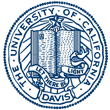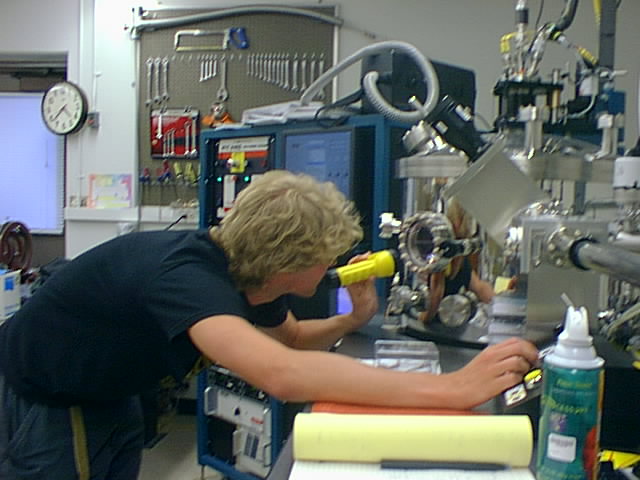
This REU program was funded through NSF PHY-0243904.


Condensed Matter Experiment
Rena Zieve
Deanna Wolfson (WPI) constructed cells for measuring the motion of a single quantized vortex in superfluid helium. The goal was to understand how a moving vortex interacts with the walls of a container. From earlier work, the vortex seems to feel a kind of friction with the walls, which drains energy as the vortex moves. In extreme cases, the vortex becomes "pinned," or unable to move at all. The cells Deanna worked on had been polished with a series of diamond pastes. While we expected the smoother walls to interact less strongly with the vortex, Deanna's cells showed exactly the opposite effect. The apparent vortex-wall friction grew larger with smooth walls, to the point that frequent pinning interfered with the measurements. Deanna helped gather data from three of her cells, using a pumped 3He refrigerator to cool to about 300 mK.Marquita Priester (Clark-Atlanta University) welded ball bearings
together to construct more complex shapes. She then measured angle
of stability for two-dimensional piles composed of various shapes.
She found that, apart from a few special cases, the shape of the container
itself has little influence on stability. Marquita also helped adjust
the analysis to calculate the particle filling fraction and correlate it
with angle of stability. It turns out that filling fraction
comes into play in two distinct ways. For a given shape particle,
denser heaps are more stable. However, when comparing different shapes,
particles with low average filling factor form the more stable heaps.
Kai Liu
Blair Willcox (U. Michigan) worked on magnetic switching of electrical transport in quasi-1-dimensional magnetic nanowires. Multilayered nanowires may be used to study how spin-polarized currents can induce magnetization-switching phenomenon. It has been reported recently in electron-beam patterned nanopillars of thick-ferromagnet/spacer/thin-ferromagnet trilayers that a current going through the thick ferromagnet (FM) layer becomes spin-polarized and exerts a torque on the magnetization direction of the thin FM layer. Consequently one can use the current to switch the magnetization direction of the thin FM layer. However, the material requirements are very stringent: the diameter of such trilayers needs to be smaller than 100 nm or so. Multilayered nanowires with tens of nanometer diameters provide an ideal system to investigate this interesting problem.Shirley Chiang
This work was done in collaboration with Frank Osterloh's group in the Chemistry Department. Thin films of metallic LiMo3Se3 nanowires respond to chemical vapors of molecular analytes with rapid (1-5 sec) and mostly reversible changes of their conductivity. To understand why, Salvador Barriga (Modesto Community College) measured electrical resistivity of nanowire films after absorption of molecules such as hydrocarbons, alcohols, and water. The absorbed molecules increased film resistivity from 0.1 ->100%. The number of absorbed molecules is correlated with the observed resistance changes, supporting the theory that direct chemical interactions between the nanowires are responsible for the conductivity changes.Condensed Matter Theory
Warren Pickett and Richard Scalettar
Evan Odabashian (Butte Community College) worked on quantum monte
carlo calculations of interacting electrons. He studied different types
and strengths of interactions, and when they lead to formation of electron
pairs. Electron pairs play a key role in superconductivity and in some
magnetic phenomena.
After the REU program finished, Evan made a short trip to Brazil to continue
his work with a collaborator of Professors Scalettar and Pickett there.
Computational Complex Systems
John Rundle
Reese Stoltzfus (Grinnell College) performed computer simulations modelling earthquake fault systems. Most computational and theoretical work on earthquakes has focused on understanding the behavior of single faults. Yet many of the significant dynamical properties of earthquakes, including the form of the Gutenberg-Richter scaling relation for the fault network, can only be understood in the context of the topologically complex network as a whole, rather than of the individual faults. Furthermore, despite the interdependence of different faults, the distribution of earthquakes also depends heavily on the stress dissipation properties of individual faults. Reese studied a model system of interconnected masses and spring. Her calculations' significance may extend beyond earthquake prediction, since network models of fault lines are closely related to models of other systems, such as neural networks or magnetic flux lines in superconductors.Nuclear Physics Experiment
Daniel Cebra
In 2002, amid substantial controversy, a group of scientists at Oak Ridge National Laboratory reported tabletop fusion caused by imploding bubbles in a beaker of acetone. The creation of bubbles followed by their rapid collapse leads to flashes of light in a phenomenon known as sonoluminescence. During the collapse the temperature within the bubble reaches extremely high temperatures, thousands or even millions of degrees. High temperatures alone do not signify fusion though, and the other experimental evidence is mixed. Because fusion would have immense practical importance as an energy source, thoroughly investigating the claims is worthwhile. The strongest evidence from the Oak Ridge experiment is detection of neutrons, a fusion byproduct. Since the measurement setup used neutrons to trigger the sonoluminescence, one concern is that the detected neutrons were simply injected during the experiment rather than created by fusion. To test these results, Michelle Hickner (Oberlin College) helped design a new experiment which will use protons rather than neutrons to initiate sonoluminescence.High Energy Experiment
Maxwell Chertok and Mani Tripathi
When the Large Hadron Collider (LHC) at CERN begins operation in 2008, it will be the largest particle accelerator ever built. A major collaboration including the UC Davis high energy experiment group designed the Compact Muon Solenoid (CMS) detector for the LHC. Over the summer, Christi Chew (U. Maryland) and Ian Derrington (U. Colorado) did Monte Carlo simulations that are needed for understanding the CMS detector. Since any physics beyond our present understanding of fundamental particles will appear through only a tiny fraction of the collisions, it is crucial to work out in advance what signatures to expect for different kinds of collisions and how many of each event to expect. Finding even a handful of extra collisions of a given type could prove that new theories are needed.Cosmology
Lloyd Knox
Alex Lampert (UCLA) studied how clusters of galaxies can be used as probes of "dark energy.'' In a cluster of galaxies, the galaxies themselves account for less than 5% of the mass of the cluster. There is much more mass in the dark matter that creates the deep gravitational potential binding the galaxies together. Statistical properties of galaxy clusters can, in principal, be used to study the mysterious "dark energy'' that pervades the Universe. Can they be used this way in practice? Alex generated artificial clusters of galaxies and simulated observations of weak lensing effects on them, then analyzed the simulated data. This will help in understanding later results of the same type of analysis on "real" data.